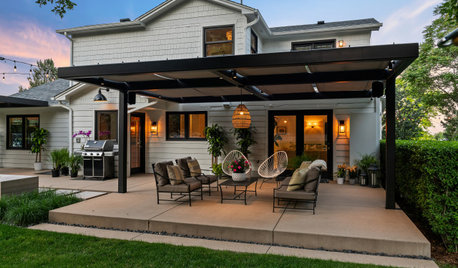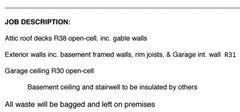Open Cell Spray Foam Insulation for new Construction
sarahbr2
8 years ago
Featured Answer
Sort by:Oldest
Comments (59)
sarahbr2
8 years agoRelated Discussions
XPS under radiant floor? open vs. closed-cell spray foam walls?
Comments (2)For soundproofing, use soundproofing materials--either constrained layer damping drywall, such as Quietrock brand or multiple drywall layers and Green Glue. Before the constrained layer drywall was invented, I used multiple layers on resilient channel. Lots of labour that can be easily short-circuited by just one wrong fastener, research shows....See MoreWhat's the pros and cons of open and closed cell foam spray?
Comments (3)I am in south Louisiana. energy_rater_la, I have no problem with overfilling the walls. I need all the R I can get, and even though I give up R=1 for a 1/2" of air, I get R=1.9 for 1.2" of spray foam, and at $.16/in-ft^2, it still marginally makes sense. For the roof, as I will generally have 2x10 rafters (i.e., 9-1/4" deep), I do not need to have insulation all the way there (the optimal level from an overall cost benefits analysis is at 8".) energy_rater_la, are you saying that I do not have a problem with having some space between the foam and the ceiling sheet rock, unlike for the walls? It would not matter much if I did go all the way to 9-1/4", although I would be paying a little more for the insulation than I would get back in reduced energy costs (using my analysis of the cost of financing and energy cost increase and expected life), as well as not taking advantage of the air space R (value of 1). As for exterior insulation, in general, the costs of the material is so high, that once the wall is at R-12 (net), the total costs of the material and labor are higher than the reduction in energy costs. Actually the cost of material alone is OK, but the extra cost of labor pushes it into being too expensive. There is a new combined structural and insulation sheathing (Dow Styrofoam SIS?), but the material cost is even higher, and it only almost makes financial sense, but with the problems of "this is new, and how good is this going to hold up". However, since the east and west walls get more insolation (and therefore more heat gain), the numbers begin to work out for exterior insulation, and there is the added benefit that the local heat gain is less, which allows those rooms to have the same heat gain as the rooms with non-insolated walls, thereby allowing a more constant indoor environment. I will be putting in an extra 2" of insulation there (which makes integrating with windows easy as all manufacturers make jambs for 6" walls.) This leaves the question of what exact type of exterior insulation should I get. There are so many different types out there - this type of foam, that type of foam, fiberglass, etc. And the idea of vapor and water barriers, foil radiant barrier, with the open cell insulation has me very confused. Fortunately, the price per R is about the same, so I don't have to make a decision based on relative price, but only on what is proper. Here are some of the brands I have researched: ProPink Foamular R-Max R-Tech Which of these is better for my situation? Are there any others I should consider? Thanx again...See MoreOpen Cell Spray Foam in Attic
Comments (1)Exactly what do you mean by "spray their attic? "If you are in a hot, humid climate like mine, costal LA, you should seal your attic and spray the underside of the roof deck. This is especially true if you have HVAC ducts in the attic. Please consider having your home evaluated by a local energy rater that knows your climate and can put eyes on your building. They will also know of local energy efficiency programs that might help you with cost. Call a hand-full and have a chat before you hire one. Your phone interview might include what types of foam are best in your climate You might start at resnet.us...See MoreThoughts on insulation in the south?
Comments (12)Sounds like you have come a long way but if you insulate at the roofline, then you shouldn't insulate between 2nd floor and attic. Either way, install enough R-value to meet code or better R40-R60. There is loose fill and dense pack for "blown in" insulation. Loose fill settles but that's generally ok in an attic situation where you can blow deeper to account for it but walls call for dense pack, best performed by insulation contractors with the proper training and equipment. Properly installed dense pack cellulose or fiberglass doesn't have much settlement. Closed Cell CC spray foam in walls is rare. Open Cell OC is what's usually used in walls because it expands past the framing and cut back flush which fills the entire cavity. Closed cell in walls is sometimes used as an initial, air-barrier and the cavity is finished off with something else like batts or dense pack. Foam board or other natural insulative sheathing is the best way to insulate because it covers structural components, which keeps them warm and reduces thermal bridging. All new homes should have fresh air intakes, which I prefer to call outdoor-air ventilation systems. These systems are largely independent of moisture and humidity issues of a home but can influence things either direction depending on home performance, operation or season. Most mold and condensation is from water leaks. 2nd most is from air-leakage which is another reason why paying attention to your blower door test results is more important than R-value measurements. Condensation problems are most common in cold weather with overly high interior humidity which is why codes are increasing R-value minimums and encouraging insulative sheathing. In all climates, many moisture problems come from the ground, so be careful with crawlspaces. Problems also develop from rain-exposed masonry with improper vapor barriers and interior vapor barriers in the form of vinyl wallpaper. As homes get more efficient, we need to do a better job of ensuring the proper installation and maintenance of bath fans and kitchen vent hoods. Details in these systems design and occupant operation make big differences. I struggle keeping my wintertime humidity low with my 6-10 houseplants....See MoreUser
8 years agolast modified: 8 years agoenergy_rater_la
8 years agosarahbr2
8 years agoSpringtime Builders
8 years agoworthy
8 years agosis33
8 years agosarahbr2
8 years agoUser
8 years agosarahbr2
8 years agoUser
8 years agolast modified: 8 years agoenergy_rater_la
8 years agosarahbr2
8 years agolast modified: 8 years agoUser
8 years agolast modified: 8 years agoUser
8 years agolast modified: 8 years agosarahbr2
8 years agoUser
8 years agoworthy
8 years agolast modified: 8 years agoUser
8 years agolast modified: 8 years agosarahbr2
8 years agorwiegand
8 years agoUser
8 years agolast modified: 8 years agoR Stevens
8 years agokeywest230
8 years agosarahbr2
8 years agoUser
8 years agosarahbr2
8 years agosarahbr2
8 years agosarahbr2
8 years agomadpebs87
8 years agolast modified: 8 years agosarahbr2
8 years agoUser
8 years agolast modified: 8 years agokeywest230
8 years agoUser
8 years agolast modified: 8 years agoenergy_rater_la
8 years agoUser
8 years agolast modified: 8 years agoHU-417647765
last year
Related Stories

MATERIALSInsulation Basics: What to Know About Spray Foam
Learn what exactly spray foam is, the pros and cons of using it and why you shouldn’t mess around with installation
Full Story
GREEN BUILDINGEcofriendly Cool: Insulate With Wool, Cork, Old Denim and More
Learn about the pros and cons of healthier alternatives to fiberglass and foam, and when to consider an insulation switch
Full Story
KNOW YOUR HOUSEKnow Your House: The Basics of Insulated Concrete Form Construction
Get peace and quiet inside and energy efficiency all around with this heavy-duty alternative to wood-frame construction
Full Story
GREEN BUILDINGInsulation Basics: Heat, R-Value and the Building Envelope
Learn how heat moves through a home and the materials that can stop it, to make sure your insulation is as effective as you think
Full Story
REMODELING GUIDESCool Your House (and Costs) With the Right Insulation
Insulation offers one of the best paybacks on your investment in your house. Here are some types to discuss with your contractor
Full Story
GREEN BUILDINGInsulation Basics: Designing for Temperature Extremes in Any Season
Stay comfy during unpredictable weather — and prevent unexpected bills — by efficiently insulating and shading your home
Full Story
GREEN BUILDINGInsulation Basics: Natural and Recycled Materials
Consider sheep’s wool, denim, cork, cellulose and more for an ecofriendly insulation choice
Full Story
WINDOW TREATMENTSEasy Green: 9 Low-Cost Ways to Insulate Windows and Doors
Block drafts to boost both warmth and energy savings with these inexpensive but effective insulating strategies
Full Story
CONTRACTOR TIPSLearn the Lingo of Construction Project Costs
Estimates, bids, ballparks. Know the options and how they’re calculated to get the most accurate project price possible
Full Story
WORKING WITH PROSYour Guide to a Smooth-Running Construction Project
Find out how to save time, money and your sanity when building new or remodeling
Full Story






mushcreek